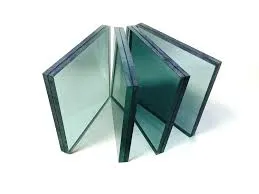The Beauty and Science of Glass Reflective Surfaces
Glass is an extraordinary material that has fascinated humanity for centuries. From its historical use in ancient Roman architecture to modern applications in skyscrapers and vehicles, glass has evolved into a crucial component of contemporary design and technology. One of the most intriguing properties of glass is its reflective ability, which not only serves functional purposes but also enhances aesthetic appeal. This article delves into the fascinating world of glass reflective surfaces, exploring their applications, benefits, and the science behind their reflective properties.
The Science of Reflection
At the heart of glass reflection is the interaction of light with the material. Glass is a transparent medium, meaning it allows light to pass through. However, when light hits the surface of glass, a portion of it is reflected while the rest is transmitted through. The amount of light reflected versus transmitted depends on several factors, including the angle of incidence, the type of glass, and any coatings that may be applied.
The phenomenon of reflection can be explained through the laws of physics. According to the law of reflection, the angle at which the light hits the surface (incident angle) is equal to the angle at which it is reflected. This principle is vital in designing reflective glass surfaces, especially in applications where glare reduction and energy efficiency are essential.
Architectural Applications
One of the most prominent uses of reflective glass is in architecture. Urban landscapes are often adorned with buildings featuring expansive glass façades, which utilize reflective properties to create stunning visual effects. Reflective glass not only adds an element of elegance to skyscrapers but also serves practical purposes. By reflecting sunlight, these surfaces can reduce heat gain, resulting in lower energy costs for cooling and lighting within the building.
In addition to energy efficiency, reflective glass enhances privacy. For instance, one-way mirror glass allows occupants to see outside while preventing outsiders from seeing in. This is particularly useful in office buildings and residential spaces. The interplay of reflection and transparency creates a seamless connection between indoor and outdoor environments, fostering a sense of openness without compromising privacy.
glass reflective
Automotive Innovations
Reflective glass also plays a significant role in the automotive industry. Windshields and windows made from specially coated reflective glass help to minimize glare from the sun, improving driver visibility and safety. Moreover, innovations in glass technology have led to the development of self-tinting glass that adjusts its reflectivity based on sunlight exposure, enhancing comfort and energy efficiency in vehicles.
The aesthetics of cars are also enhanced by the use of reflective glass. Manufacturers often opt for tinted or reflective glass to give vehicles a sleek, modern look. This application not only improves the car's visual appeal but also serves functional purposes like UV protection and temperature regulation inside the vehicle.
Environmental Considerations
As the globe shifts towards sustainability, the role of reflective glass in energy conservation cannot be overlooked. The latest advancements in glass technology include low-emissivity (low-E) glass, designed to reflect infrared radiation while allowing visible light to pass through. This not only regulates indoor temperatures but also reduces reliance on artificial lighting, ultimately lowering energy consumption in buildings.
Reflective glass also contributes to the concept of green architecture. By integrating reflective surfaces, architects and builders can create structures that are both aesthetically pleasing and environmentally friendly. Additionally, using glass in eco-friendly designs supports the idea of biophilic architecture, which emphasizes harmony between humans and nature.
Conclusion
In conclusion, glass reflective surfaces are a remarkable intersection of science, design, and sustainability. Their ability to enhance aesthetic appeal while serving practical functions has made them a staple in architecture and automotive design. As advancements in technology continue to evolve, the future of glass and its reflective properties seems bright, promising innovative applications that prioritize energy efficiency, sustainability, and beauty. Whether used in towering skyscrapers or sleek automobiles, reflective glass will undoubtedly remain a key player in shaping the visual and functional landscape of our world.
 Afrikaans
Afrikaans  Albanian
Albanian  Amharic
Amharic  Arabic
Arabic  Armenian
Armenian  Azerbaijani
Azerbaijani  Basque
Basque  Belarusian
Belarusian  Bengali
Bengali  Bosnian
Bosnian  Bulgarian
Bulgarian  Catalan
Catalan  Cebuano
Cebuano  Corsican
Corsican  Croatian
Croatian  Czech
Czech  Danish
Danish  Dutch
Dutch  English
English  Esperanto
Esperanto  Estonian
Estonian  Finnish
Finnish  French
French  Frisian
Frisian  Galician
Galician  Georgian
Georgian  German
German  Greek
Greek  Gujarati
Gujarati  Haitian Creole
Haitian Creole  hausa
hausa  hawaiian
hawaiian  Hebrew
Hebrew  Hindi
Hindi  Miao
Miao  Hungarian
Hungarian  Icelandic
Icelandic  igbo
igbo  Indonesian
Indonesian  irish
irish  Italian
Italian  Japanese
Japanese  Javanese
Javanese  Kannada
Kannada  kazakh
kazakh  Khmer
Khmer  Rwandese
Rwandese  Korean
Korean  Kurdish
Kurdish  Kyrgyz
Kyrgyz  Lao
Lao  Latin
Latin  Latvian
Latvian  Lithuanian
Lithuanian  Luxembourgish
Luxembourgish  Macedonian
Macedonian  Malgashi
Malgashi  Malay
Malay  Malayalam
Malayalam  Maltese
Maltese  Maori
Maori  Marathi
Marathi  Mongolian
Mongolian  Myanmar
Myanmar  Nepali
Nepali  Norwegian
Norwegian  Norwegian
Norwegian  Occitan
Occitan  Pashto
Pashto  Persian
Persian  Polish
Polish  Portuguese
Portuguese  Punjabi
Punjabi  Romanian
Romanian  Russian
Russian  Samoan
Samoan  Scottish Gaelic
Scottish Gaelic  Serbian
Serbian  Sesotho
Sesotho  Shona
Shona  Sindhi
Sindhi  Sinhala
Sinhala  Slovak
Slovak  Slovenian
Slovenian  Somali
Somali  Spanish
Spanish  Sundanese
Sundanese  Swahili
Swahili  Swedish
Swedish  Tagalog
Tagalog  Tajik
Tajik  Tamil
Tamil  Tatar
Tatar  Telugu
Telugu  Thai
Thai  Turkish
Turkish  Turkmen
Turkmen  Ukrainian
Ukrainian  Urdu
Urdu  Uighur
Uighur  Uzbek
Uzbek  Vietnamese
Vietnamese  Welsh
Welsh  Bantu
Bantu  Yiddish
Yiddish  Yoruba
Yoruba  Zulu
Zulu 

